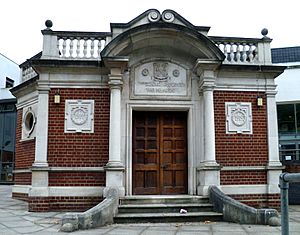Hornsey War Memorial facts for kids
The Hornsey War Memorial is a special place in Hornsey, London. It stands on Park Road, right in front of the Hornsey Central Hospital. This hospital used to be known as the Hornsey Memorial Hospital.
This memorial helps us remember the brave men from the Hornsey area who lost their lives during the First World War. It looks like a small chapel made of red brick with special Portland stone decorations.
Contents
Remembering Heroes: The Hornsey War Memorial
What is a War Memorial?
A war memorial is a monument built to honor people who died in wars. It helps communities remember the sacrifices made by soldiers. These memorials often list the names of those who served or have symbols of peace and remembrance. They are important places for reflection.
Who Designed This Special Chapel?
The Hornsey War Memorial was designed by an architect named George Lethbridge. It was officially opened and dedicated in 1921. Inside the chapel, you can find plaques with the names of the people who died.
What Does the Memorial Look Like?
The main part of the memorial is a small chapel. It's built with red bricks and has fancy details made from Portland stone. This stone is a famous type of white limestone often used in important buildings.
Next to the chapel, there's a small grassy area. You'll find stone benches there where people can sit and think. There's also a modern V-shaped wall. This wall holds the original plaques that explain how and why the memorial was built.
Why Was the Memorial Renovated?
The chapel was renovated, or updated, between 2007 and 2009. This happened when the old Hornsey Memorial Hospital was taken down and a new hospital was built in its place. The renovation helped keep the memorial in good condition for future generations.
What Does 'Grade II Listed' Mean?
The Hornsey War Memorial is a grade II listed building with Historic England. This means it's considered a very important historical building. Being "listed" protects it, making sure it can't be changed or knocked down without special permission. It helps preserve our history.


